| On Monday, March 4th, it was really cold out (in the 20's again)
and I was the only one at Labor Ready at 5AM (though Angie opened promptly at
5AM). I got an assignment with General Stevedores unloading barges with rolls
of steel (they call them coils). It is a nice assigment at $6 an hour and moderate
overtime and they seem happy with me, so I may be here a while. In this picture
you can see an empty barge on the left with the large front loader next to it.
They use the front loader to pull the covers from one end of the barge to another
(they alternate high and low and slip past each other if the latches are open)
as well as moving the barge sometimes. To the right of the barge is the crane
which unloads the coils (or rolls) and some coils of steel (one galvanized and
wrapped in paper and the others unwrapped and uncoated). |
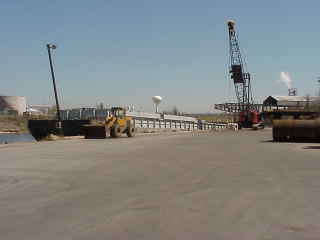 |
| Across Buffalo Bayou from us is a refinery of some sort. This
is the view I regularly see of it. The barges are much lower the water when
they come in (by about eight feet). I have been mostly working on the dock
helping to aline the steel roll when it comes down so that the fork lift can
pick it up. The rolls are three to six feet high and have an opening about
two feet wide in the center. They mostly weigh from 8,000 to 60,000 pounds
depending on what kind of steel it is. Needless to say, I stay out of the
way and get mostly isometric exercise (lots of pushing with little movement)
as I just get it to spinning and then let the operator drop it when the center
is aligned where the forklift can get at it. |
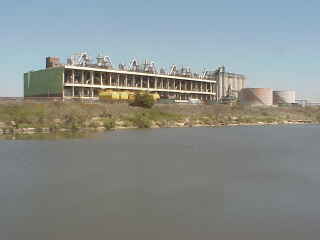 |
| This is the warehouse where they keep the paper wrapped steel
(actually wrapped in nylon tarp material) so it doesn't get wet. Outside are
unwrapped steel coils which can get rained on. I also do miscellaneous other
tasks that need doing like marking the coils as directed, connecting the cable
to the front loader, putting the connector on to the hook for the crane, ....
The crane has a hook that rotates easily at the end of a series of pulleys
(actually two with different pulley's). The rolls are loaded on a C shaped
(but with right angles rather than any bend) attachment which probably
weights up to 4,000 pounds itself. At the center of the top of these
attachments (there are about six of different sizes and such) is a steel
loop that often weighs about 50 pounds. I just lift it onto (and off) the
hook of the crane. There are two guys in the barge when we are working
who help guide the C hook through the center of the roll to picked up. |
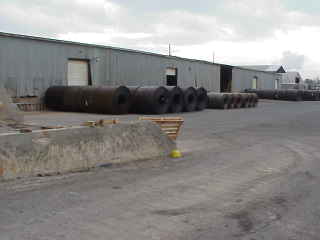 |
| Here is the area where they keep the attachments for the
crane. The closest C hook is the one used for coils of over 40,000
pounds. I would guess it weighs about 2,000 pounds itself. All the
workers are quite safety conscious (with good reason) as is the company. To
the right of the heavy duty C hook is the man cage. We are not allowed to
ride over to the barge and back (or anywhere else) via the crane unless we
are in the man cage. I had to sign a paper saying I had read their safety
rules and would abide by them before I started and that was one of the
rules. However, I have seen people riding C hooks on occassion, so I
imagine that that is considered one of the needless safety rules. To
the left and rear of the heavy duty C hook is a caddy which can pick up
two smaller coils at the one time. |
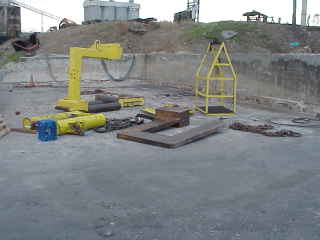 |
| Behind the area for crane hooks is where we store lumber
we retrieve from the barges. This is unfinished lumber which was used
underneath the coils and to chock them (keep them from rolling). This
lumber is then moved to the other warehouses such as the one which loads
the coils onto rail cards and needs the lumbers for the same purpose
there. We will stack the rails on a forklift and then band it with steel
bands when we have an hour or so and no barge to unload. We also have a
bucket of diesel (left rear) and 55 gallon drum for fires on cold days
when we are waiting for work to do. |
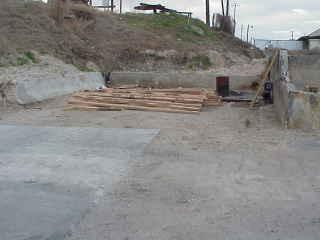 |
| Here is one of the heavy duty forklifts with a single attachment
for picking up one large coil. When we are stacking lunber, it would have the
more traditional two flat ends for us to put lumber on. For lighter (10,000
pounds) coils they would put round covers over the ends and use it to pick up
two coils at a time. |
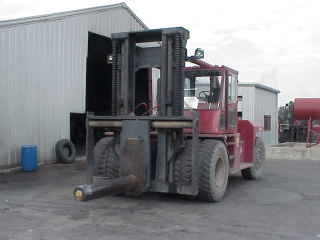 |
| Here is a barge with its lid closed. We hook a cable to one
of the sections and start pulling it to one end with the front loader. The
taller/larger sections have wheels on the outside of the track and go over
the lower/smaller sections which have wheels on the inside of the track.
That will open up half the barge. Then we pull the sections to the other
end to empty the other half. |
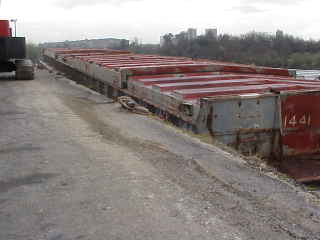 |
| Here is what the inside of a barge looks when the covers are
off and it has unwrapped steel. These coils tend to be larger and heavier
and so there are less per barge. Probably only about 50 to 60 per barge. |
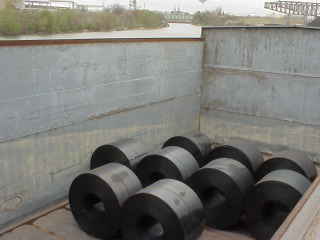 |







